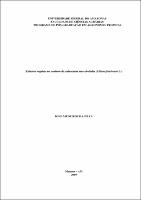| ???jsp.display-item.social.title??? |


|
Please use this identifier to cite or link to this item:
https://tede.ufam.edu.br/handle/tede/7080| ???metadata.dc.type???: | Dissertação |
| Title: | Extratos vegetais no controle da antracnose em cebolinha |
| Other Titles: | Extracts in the control of anthracnose in chives |
| ???metadata.dc.creator???: | Silva, Ione Medeiros da  |
| ???metadata.dc.contributor.advisor1???: | Lima, Jânia Lília da Silva Bentes |
| First advisor-co: | Ferreira, Ana Francisca |
| ???metadata.dc.contributor.referee1???: | Gentil, Daniel |
| ???metadata.dc.contributor.referee2???: | Demosthenes, Liane |
| ???metadata.dc.description.resumo???: | A cebolinha, é uma hortaliça bastante conhecida e utilizada pela população brasileira. Durante o seu cultivo, as plantas ficam expostas a doenças causadas por fungos e bactérias. Dentre as doenças de origem fúngica, destaca-se a antracnose, causada por fitopatógeno do gênero Colletotrichum, de fácil disseminação e sobrevivendo parasitando vegetais. O objetivo deste trabalho foi avaliar os extratos, obtidos a partir das plantas Picrolema sprucei, Piper marginatum, Croton cajucara, Curcuma longa e Laportea aestuans, no controle de antracnose da cebolinha. O experimento foi desenvolvido no Laboratório de Microbiologia e Fitopatologia e em casa de vegetação da Faculdade de Ciências Agrárias, Universidade Federal do Amazonas, onde foram realizadas caracterização morfológica e identificação molecular de Colletotrichum sp. associados à antracnose da cebolinha; obtenção e avaliação dos (EBA) Extratos Brutos Aquosos; obtenção e avaliação das frações hexânicas, acetato-etílicas e metanólicas dos extratos vegetais; avaliação do efeito dos extratos fracionados no crescimento micelial (ICM) e Porcentagem de Inibição de Esporulação (PIE). Os dados foram submetidos à análise de variância (ANOVA), quando constatada significância, por intermédio do teste F, as médias foram comparadas pelo Teste de Tukey ao nível de 5 % de probabilidade. No ensaio in vitro com o extrato bruto aquoso (EBA), o menor valor de ICM foi obtido com os tratamentos Piper marginatum e Picrolema sprucei. Quanto a PIE, o maior valor foi obtido a concentração de 50%, sendo que o EBA de Croton cajucara apresentou maior inibição da esporulação do fitopatógeno. Já para o ensaio in vitro com os extratos fracionados, o menor valor de ICM foi obtido com a fração acetílica de Curcuma longa. Quanto a PIE, o maior valor, foi obtido com a fração metanólica de Picrolema sprucei. No ensaio in vivo, os extratos de Píper marginatum e Picrolema sprucei apresentaram melhor desempenho no controle da severidade da doença. |
| Abstract: | The chives, is a vegetable well known and used by the Brazilian population. During their cultivation, plants are exposed to diseases caused by fungi and bacteria. Among the diseases of fungal origin, the anthracnose, caused by phytopathogen of the genus Colletotrichum, of easy dissemination and surviving parasitizing vegetables stands out. The objective of this work was to evaluate the extracts obtained from the plants Picrolema sprucei, Piper marginatum, Croton cajucara, Curcuma longa and Laportea aestuans, in the control of anthracnose of chives. The experiment was carried out in the Laboratory of Microbiology and Phytopathology and in a greenhouse of the Faculty of Agrarian Sciences, Federal University of Amazonas, where morphological characterization and molecular identification of Colletotrichum sp. associated with anthracnose of chives; Obtaining and Evaluating (EBA) Aqueous Crude Extracts; obtaining and evaluating the hexane, acetate-ethylic and methanolic fractions of plant extracts; evaluation of the effect of fractionated extracts on mycelial growth (ICM) and Esporulation Inhibition Percentage (PIE). The data were submitted to analysis of variance (ANOVA), when the significance was verified, through the F test, the means were compared by the Tukey test at the 5% probability level. In the in vitro test with crude aqueous extract (EBA), the lowest ICM value was obtained with the treatments Piper marginatum and Picrolema sprucei. As for PIE, the highest value was obtained at a concentration of 50%, and the EBA of Croton cajucara presented greater inhibition of sporulation of the phytopathogen. As for the in vitro assay with fractionated extracts, the lowest ICM value was obtained with the acetylic fraction of Curcuma longa. As for PIE, the highest value was obtained with the methanolic fraction of Picrolema sprucei. In the in vivo assay, the extracts of P. marginatum and Picrolema sprucei showed better performance in controlling the severity of the disease. |
| Keywords: | Colletotrichum sp Cebolinha Controle alternativo Alternative control Doenças de origem fúngica Antracnose Fitopatógeno |
| ???metadata.dc.subject.cnpq???: | CIÊNCIAS AGRÁRIAS |
| Language: | por |
| ???metadata.dc.publisher.country???: | Brasil |
| Publisher: | Universidade Federal do Amazonas |
| ???metadata.dc.publisher.initials???: | UFAM |
| ???metadata.dc.publisher.department???: | Faculdade de Ciências Agrárias |
| ???metadata.dc.publisher.program???: | Programa de Pós-graduação em Agronomia Tropical |
| Citation: | Silva, Ione Medeiros da. Extratos vegetais no controle da antracnose em cebolinha. 2019. 59 f. Dissertação (Mestrado em Agronomia Tropical) - Universidade Federal do Amazonas, Manaus, 2019. |
| ???metadata.dc.rights???: | Acesso Aberto |
| ???metadata.dc.rights.uri???: | http://creativecommons.org/licenses/by-nc-nd/4.0/ |
| URI: | https://tede.ufam.edu.br/handle/tede/7080 |
| Issue Date: | 28-Feb-2019 |
| Appears in Collections: | Mestrado em Agronomia Tropical |
Files in This Item:
| File | Description | Size | Format | |
|---|---|---|---|---|
| Dissertação_IoneSilva_PPGATR.pdf | 1.02 MB | Adobe PDF |  Download/Open Preview |
This item is licensed under a Creative Commons License





